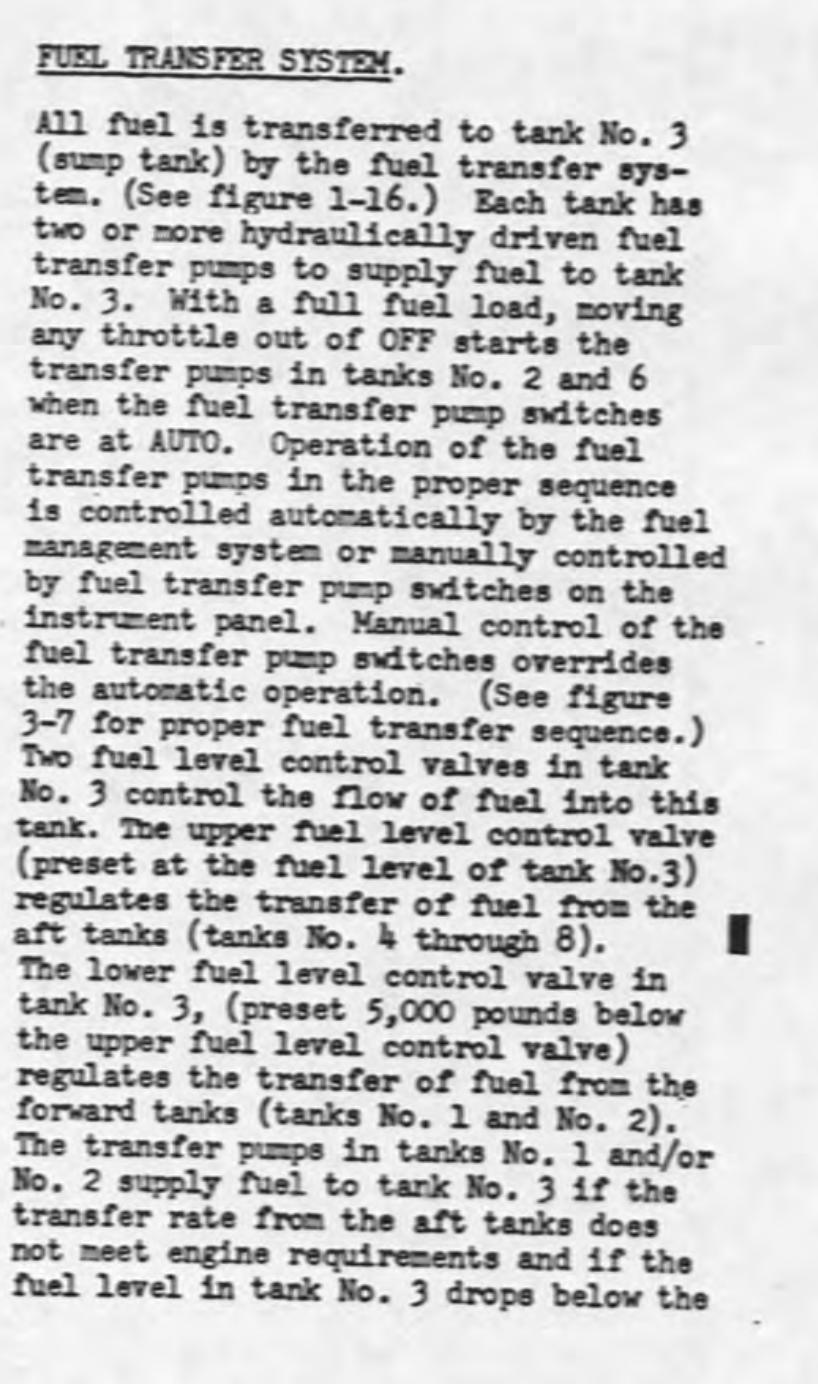The XB-70 had a large number of fuel transfer pumps (something like 25) to transfer fuel from the 10 other tanks into the sump tank, and then three fuel "boost" pumps to pump it from that to the engines. These were hydraulically driven pumps. I.e. it was the hydraulic pressure in the corresponding hydraulic system that caused such a fuel pump to do its work. How common was that back in the days? Do such pumps exist on any current aircraft?
2 Answers
Not common in commercial aircraft.
For this comparative analysis I used a DOT/FAA study titled Commercial Aircraft Airframe Fuel Systems Survey and Analysis by P. G. Weitz.
Searching the whole document, I found only one other aircraft with hydraulically-driven fuel pumps; of 32 fuel pumps, two were hydraulically-driven on Concorde.
Thirty electrically driven centrifugal pumps and 2 hydraulically driven centrifugal pumps are supplied. Twelve of these run continuously and up to 18 are running during portions of the flight. The pumps have flow ratings of 2000 gal/hr to 12,000 gal/hr. No ejector pumps are used on this aircraft. [Weitz, p. 5-7]
Checking Concorde's flight manual, both pumps were transfer pumps in the aft tank (no. 11), and each was powered by a different hydraulic system; they were alongside two electrically-driven pumps for a total of four in tank 11.
The flight manual does not explain the reasoning, but another question here may shed some light on it: Could the Olympus 593 have been windmill-restarted during supersonic flight?
In an all-engine flame-out in supersonic flight, hydraulic-driven emergency power generation is used, and fuel is pumped forward from tank 11 to counteract the ensuing forward shift of lift as the plane goes subsonic. Since the engines will be windmilling, the IDGs may not provide the needed electrical output, whereas hydraulic pressure from at least the stored pressure in the hydraulic reservoirs will help provide the remaining necessary pumping power, at least until subsonic CG-trim is achieved for a worst-case scenario of gliding with no re-light.
Subsonic airplanes do not have this critical requirement of pumping fuel forward, which may explain why they are not common.
-
$\begingroup$ I think the reason two fuel pumps were hydraulic was that the RAT drove two emergency hydraulic pumps to power the Green and Yellow hydraulic systems in an all-engine-out situation. $\endgroup$– John KCommented Dec 6, 2021 at 5:04
-
2$\begingroup$ @JohnK Can RAT be used at supersonic speed? $\endgroup$ Commented Dec 6, 2021 at 7:31
-
1$\begingroup$ @user3528438 At supersonic speeds, flamed out engines on Concorde would still produce full electrical power from windmilling down to around mach 1.1 and hydraulic power down to mach 0.7. The RAT was designed for subsonic deployment when windmilling was no longer effective. I recall a story about a concorde RAT being accidentally deployed at mach 2 (and surviving, seemingly ok) but don't have a reference handy. $\endgroup$– J...Commented Dec 6, 2021 at 13:31
Not common, no:
The pumps mentioned in OP are fuel transfer pumps, necessary for the shift of Mean Aerodynamic Centre in supersonic flight. Subsonic aeroplanes do not require fuel transfer in longitudinal direction.1
A hydraulically driven fuel pump is subject to failures in the pump itself, plus failures in the hydraulic system driving it: leaks, dirty filters, burst pipes etc. Meaning an exponential increase in chance of failure of the hydraulically driven fuel pump.
So no, hydraulically driven fuel transfer pumps are not common. By way of comparison: the B737 has fuel pumps that are mechanically driven by the engines, plus AC driven electric pumps and gravity transfer to the centre tank as a backup option.
1 The A380 has a fuel trim tank in the horizontal stabiliser, if the transfer pumps fail fuel can be transferred back into the main tank via gravity.
-
3$\begingroup$ The usage of horizontal stabiliser fuel trim tank dates is a classical on Airbus long-range models, at is was present on Airbus A330/A340. Such a tank is also present on at least on Boeing 747-400 $\endgroup$– JoëlCommented Dec 6, 2021 at 6:26
-
$\begingroup$ (Also the fuel boost pumps in the XB-70, that pumped fuel from the "sump" tank to the engines, were hydraulically driven, although the snippet in my screenshot doesn't mention those.) $\endgroup$– tmlCommented Dec 6, 2021 at 8:41
-
$\begingroup$ I suspect that even with the fuel trim tank inoperable in any way (full/empty), the stabiliser of an ordinary airliner is more than strong enough to compensate and keep the aircraft trimmed. Deltas like the XB-70 or the Concorde have no such redundancy. $\endgroup$– TooTeaCommented Dec 6, 2021 at 8:51
-
3$\begingroup$ @Tootea It's the shift in MAC that necessitates pumping fuel around in supersonic aeroplanes, not possible to trim it away, the CoG needs to shift accordingly. $\endgroup$– KoyovisCommented Dec 6, 2021 at 10:18
-
1$\begingroup$ The first Airbus with a trim tank was the A310. It then went on the A300-600 and as mentioned the A330/A340. The A350 does not. The MD-11 also has a trim tank. $\endgroup$ Commented Dec 6, 2021 at 17:06


